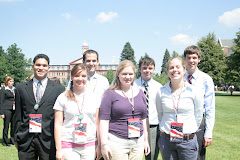by Lee Jolliffe, Drake J-prof
I last saw Colorado in the 1970s. My family vacationed and I worked a summer at Snow Mountain Ranch YMCA of the Rockies. We loved it—trail rides and hikes in the unspoiled mountains, bears and coyotes and hummingbirds, mountain goats and the occasional fly fisherman.
Those were the days when middle class families drove for every trip; airline tickets for a whole family were out of the question. I still like to stay on the ground when I travel. And since MapQuest said it was a mere 569 miles from Des Moines to Denver, I drove this year too.
Either MapQuest or I made a 100-mile mistake. Make that 690 miles, total. But I enjoyed the drive for the most part, and got to see the landscape. Driving gives me a true sense of traveling, of crossing the terrains I’m in. I might be tired when I get there, but I will know how far I’ve come.
Iowa is a rumpled coverlet of green, with the hills and valleys like a pleasantly unmade bed. Nebraska farms sprawl more and gradually, traveling west, there’s a shift from corn and soybeans to cattle on fields that are less and less green as you drive past the midpoint. Western Nebraska had fields and fields of sunflowers, some the large, seed-crop type, others the smaller cut-flower variety that shyly ducks its head. Later in Denver, I would see them being sold as cut flowers in the grocery store florists.
When the road diving southward into Colorado, I expected the desert of the 1970s, where tenacious weeds grew the size of bushes, and little grass clung to the dry ground.
Some of the terrain was still like that, but startling green fields were also evident and the land was much more heavily settled than I remembered – or expected. Irrigation machinery explained the change.
One thing that hadn’t changed: Out in the “country” of Colorado, citified building materials cost the earth, and houses were often housetrailers that had been gradually growing outward with porches and decks and awnings and sheds, until the original metal shelter was scarcely visible. Later, I would be invited to a prominent professor’s home in Colorado Springs and see the wide economic divide between more worldly and more rural folks here. That home was on a plateau overlooking Pike’s Peak, with huge lofty rooms, stone fireplaces, a grand piano, and several patios and wide windows overlooking the mountain view. (The road TO the home was still very Coloradan: partly blacktopped, with lots of sloppy washouts around the edges.
Approaching Denver from the northwest, I was shocked by the settlement of what they call their “high plains”. A strip of land just east of the mountains and extending from Fort Collins south through Denver and clear to Colorado Springs is all jammed with settlement now—big box stores, shopping centers, and the dreaded tan-colored, all-the-same housing developments have the night sky lit for miles and miles.
Denver itself has of course grown. The skyscrapers are jammed together and form what must be a nightmare for security people, dreading snipers. The urban sprawl is largely Coloradan, by which I mean, freeform, “don’t-fence-me-in” buildings and zoning. Most of the homes are small by Iowa standards, as are their lots. But no one seems particularly houseproud, either. I think they’re all out hiking and snowboarding, too busy for perfect lawns and windowboxes.
Getting here a week ahead of the Convention gave us a chance to explore, get acclimated to the sudden shift from sea level to 5,000 feet, and somehow start to lay claim to the city as ours.
More than one student has complained that “All these people are invading OUR city.”
Tuesday, August 26, 2008
Subscribe to:
Post Comments (Atom)


No comments:
Post a Comment